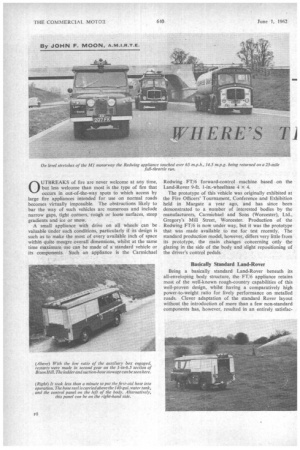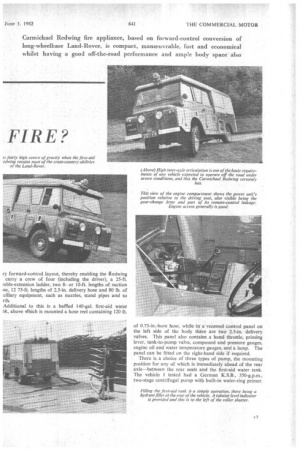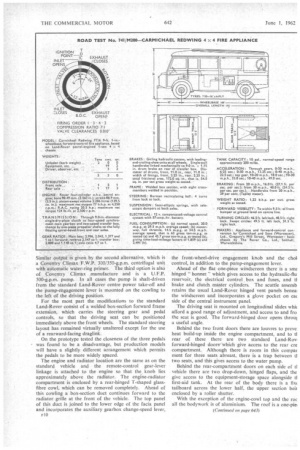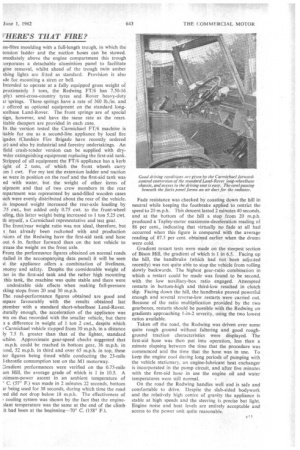O UTBREAKS of fire are never welcome at any time, but
Page 82

Page 83

Page 84

Page 87

If you've noticed an error in this article please click here to report it so we can fix it.
less welcome than most is the type of fire that occurs in out-of-the-way spots to which access by large fire appliances intended for use on normal roads becomes virtually impossible. The obstructions likely to bar the way of such vehicles are numerous and include narrow gaps, tight corners, rough or loose surfaces, steep gradients and ice or snow.
A small appliance with drive on all wheels can be valuable under such conditions, particularly if its design is such as to make the most of every available inch of space within quite meagre overall dimensions, whilst at the same time maximum use can be made of a standard vehicle or its components. Such an appliance is the Carmichael Redwing FT/6 forward-control machine based on the Land-Rover 9-ft. 1-in.-wheelbase 4 X 4.
The prototype of this vehicle was originally exhibited at the Fire Officers' Tournament, Conference and Exhibition held in Margate a year ago, and has since been demonstrated to a number of interested bodies by the manufacturers, Carmichael and Sons (Worcester), Ltd., Gregory's Mill Street, Worcester. Production of the Redwing FT/6 is now under way, but it was the prototype that was made available to me for test recently. The standard production model, however, differs very little from its prototype, the main changes concerning only the glazing in the side of the body and slight repositioning of the driver's control pedals.
Basically Standard Land-Rover
Being a basically standard Land-Rover beneath its all-enveloping body structure, the FT/6 appliance retains most of the well-known rough-country capabilities of this well-proven design, whilst having a comparatively high power-to-weight ratio for lively performance on metalled roads. Clever adaptation of the standard Rover layout without the introduction of more than a few non-standard components has, however, resulted in an entirely satisfac ry forward-control layout, thereby enabling the itedwing carry a crew of four (including the driver), a 25-ft cble-extension ladder, two 8or 10-ft. lengths of suction Ise, 12 75-ft. lengths of 2.5-in, delivery hose and 80 lb. of ciliary equipment, such as nozzles, stand pipes and so rth.
Additional to this is a baffled 140-gal first-aid water rik, above which is mounted a hose reel containing 120 ft.
of 0.75-in.-bore hose, white in a recessed control panel on the left side of the body there are two 2.5-in, delivery. valves. This panel also contains a hand throttle, priming lever, tank-to-pump valve, compound and pressure gauges, engine oil and water temperature gauges, and a lamp. The panel can be fitted on the right-hand side if required.
There is a choice of three types of pump, the mounting position for any of which is immediately ahead of the rear axle—between the rear seats and the first-aid water. tank. The vehicle I tested had a German K.S.B., 350-g.p.m., two-stage centrifugal pump with built-in water-ring primer. Similar output is given by the second alternative, which is a Coventry Climax :F.V R 300/350-g.p.m. centrifugal unit with .automatic water-ring primer. The third option is also of Coventry Climax manufacture and is a U.F.P. 500-g.p.m. pump. In all cases the pump is shaft-driven from the standard Land-Rover centre power take-off and the pump-engagement lever is mounted on the cowling to the left of the driving position.
For the most part the modifications to the standard Land-Rover consist of a welded box-section forward frame extension, which carries the steering gear and pedal controls, so that the driving seat can be positioned immediately above the front wheels. The standard steering layout has remained virtually unaltered except for the use of a rearward-facing draglink.
On the prototype tested the closeness of the three pedals was found to be a disadvantage, but production models will have a slightly, different arrangement which permits the pedals to be more widely spaced.
The engine and radiator location are the same as on the standard vehicle and the remote-control gear-lever linkage is attached to the engine so that the knob lies approximately above the radiator. The engine-radiator compartment is enclosed by a rear-hinged T-shaped glassfibre cowl, which can be removed completely. Ahead of this cowling a box-section duct continues forward to the radiator grille at the front of the vehicle. The top panel of this duct is joined to the lower edge of the facia panel and incorporates the auxiliary gearbox change-speed lever, F i 0 the front-wheel-drive engagement knob and the chol control, in addition to the pump-engagement lever.
Ahead of the flat one-piece windscreen there is a slim hinged " bonnet " which gives access to the hydraulic-flu reservoir, the electrical control box and fuses, and tl brake and clutch master cylinders. The scuttle assemb retains the usual Land-Rover, hinged vent panels beneal the windscreen and incorporates a glove pocket on eat side of the central instrument panel.
The driving seat is mounted on longitudinal slides will( afford a good range of adjustment, and access to and fro the seat is good. The forward-hinged door opens throul a useful angle.
Behind the two front doors there are louvres to preve heat build-up inside the engine compartment, and to tl rear of these there are two standard Land-Roy forward-hinged doorswhich give access to the rear cre compartment. Although there is room in this cow pal ment for three seats abreast, there is a trap between tl two seats, and this gives access to the water pump.
Behind the rear-compartment doors on each side of tl vehicle there are two drop-down, hinged flaps, and the give access to the equipment-storage space alongside ti first-aid tank. At the rear of the bogy there is a fixt tailboard across the lower half, the upper section bell enclosed by a roller shutter.
With the exception of the engine-cowl top and the roc all the bodywork is of aluminium. The roof is a one-pie (Continued on page 643) iss-fibre moulding with a full-length trough, in which the tension ladder and the suction hoses can be stowed. kmediately above the engine compartment this trough :orporates a detachable aluminitim panel to facilitate gine removal, whilst ahead of the trough twin amber shing lights are fitted as standard. Provision is also de for mounting a siren or bell.
Intended to operate at a fully equipped gross weight of proximately 3 tons, the Redwing FT/6 has 7.50-16 .ply) semi-cross-country tyres and Rover heavy-duty 1r springs. These springs have a rate of 360 lb./in, and offered as optional equipment on the standard longteelbase Land-Rover. The front springs are of special sign, however, and have the same rate as the rears. itable dampers are provided in each case.
In the version tested the Carmichael FT/6 machine is itable for use as a second-line appliance by local fire igades (Cheshire Fire Brigade have recently ordered Jr) and also by industrial and forestry undertakings. An .field crash-tender version can be supplied with drywder extinguishing equipment replacing the first-aid tank. Stripped of all equipment the FT/6 appliance has a kerb :ight of 2 tons, of which the front wheels carry on 1 cwt. For my test the extension ladder and suction Se were in position on the roof and the first-aid tank was ed with water, but the weight of other items of uipment and that of two crew members in the rear mpartment was represented by sand-filled wooden cases kich were evenly distributed about the rear of the vehicle. is imposed weight increased the rear-axle loading by .75 cwt., but added only 0.75 cwt. to the front-wheel Kling, this latter weight being increased to 1 ton 5.25 cwt. th myself, a Carmichael representative and test gear.
The front/rear weight ratio was not ideal, therefore, but s has already been reckoned with and production rsions of the Redwing have the first-aid tank and hose out 6 in. farther forward than on the test vehicle to Tease the weight on the front axle.
From the performance figures obtained on normal roads, !tailed in the accompanying data panel) it will be seen a the appliance offers a combination of liveliness, momy and safety. Despite the considerable weight of .ter in the first-aid tank and the rather high mounting this tank, the machine was (mite stable and there were undesirable side effects when making full-pressure Jking stops from 20 and 30 m.p.h.
The. road-performance figures obtained are good and mpare favourably with the results obtained last ptember with a standard short-wheelbase Land-Rover. aurally enough, the• acceleration of the appliance was wn on that recorded with the smaller vehicle, but there ,s a difference in weight of 1 ton 2 cwt., despite which ! Carmichael vehicle stopped from 30 m.p.h. in a distance ly 7.5 ft. greater than that of the lighter, standard whine. Approximate gear-speed checks suggested that m.p.h. could be reached in bottom gear, 36 m.p.h. in • ond, 52 m.p.h. in third and over 65 m.p.h. in top, these ter figures being timed while conducting the 23-mile 1-throttle consumption test on the M1 motorway.
:1radient performances were verified on the 0.75-mile ;on Hill, the average grade of which is I in 10.5. A kximum-power ascent in an ambient temperature of ' C. (57° F.) was made in 2 minutes 22 seconds, bottom tr being used for 38 seconds, during which time the road !ed did not drop below 18 m.p.h. The effectiveness of cooling system was shown by the fact that the engine31ant temperature was the same at the end of the climb it had been at the beginning-70° C. (158° F.1. Fade resistance was checked by coasting down the hill in neutral while keeping the footbrake applied to restrict the speed to 20 m.p.h. This descent lasted 2 minutes 40 seconds, and at the bottom of the hill a stop from 20 m.p.h. produced a Tapley-meter maximum-deceleration reading of 86 per cent., indicating that virtually no fade at all had occurred when this figure is compared with the average reading of 87.5 per cent. obtained earlier when the drums were cold.
Gradient restart tests were made on the steepest section of Bison Hill, the gradient of which is 1 in 6.5. Facing up the hill, the handbrake (which had not been adjusted recently) was not quite able to stop the vehicle from rolling slowly backwards. The highest gear-ratio combination in which a restart could be made was found to be second, with the low auxiliary-box ratio engaged. Attempted restarts in bottom-high and third-low resulted in clutch slip. Facing down the hill, the handbrake proved powerful enough and several reverse-low restarts were carried out. Because of the ratio multiplication provided by the two gearboxes, restarts should be possible with the Redwing on gradients approaching 1-in-2 severity, using the two lowest ratios available.
Taken off the road, the Redwing was driven over some quite rough ground without faltering and good roughground traction characteristics were displayed. The first-aid hose was then put into operation, less than a minute elapsing between the time that the procedure was commenced and the time that the hose was in use. To keep the engine cool during long periods of pumping with the vehicle stationary, an engine-lubricant heat exchanger is incorporated in the pump circuit, and after five minutes with the first-aid hose in use the engine oil and water temperatures were still normal.
On the road the Redwing handles well and is safe and comfortable to drive. Despite the slab-sided bodywork and the relatively high centre of gravity the appliance is stable at high speeds and the steering is precise but light.
Engine noise and heat levels are entirely acceptable and access to the power unit quite reasonable.






































































































































































